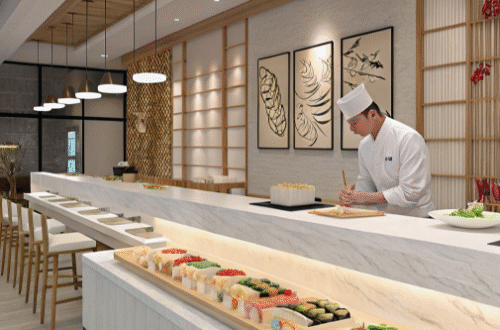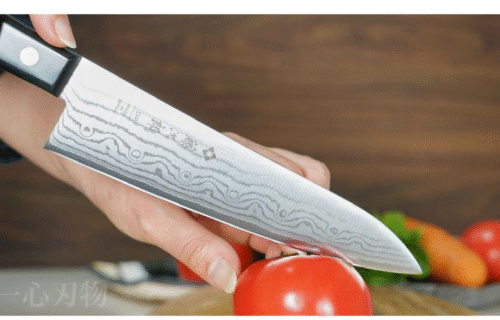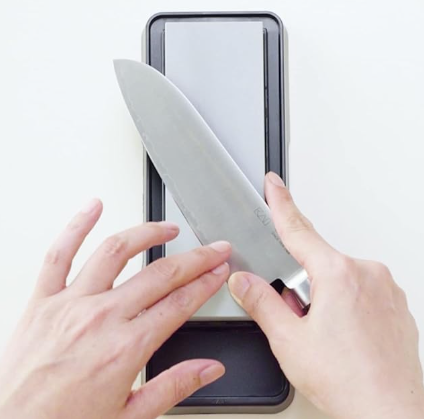
05-01-4. Preserving Perfection: Essential Care and Maintenance for Your Wabocho Knife
we explored the deep history of Japanese knives, their diverse types, and the craftsmanship that goes into their manufacture. Japanese knives are not merely cooking tools; they are works of art that embody the essence of Japanese food culture. However, no matter how excellent a knife may be, it cannot fulfill its true potential without proper care.
In this chapter, we will provide a detailed explanation of the essential care and maintenance methods needed to keep your Japanese knife in optimal condition for a lifetime. From daily basic care to the sharpening techniques that determine sharpness, and proper storage methods, we provide practical knowledge to ensure your Japanese knife continues to shine and bring joy to cooking. Caring for a Japanese knife is not merely a task but an act of respect for the craftsmanship and dedication embedded in its blade. Let’s begin the journey to keep your Japanese knife in perfect condition.
4.1 Daily Rituals: Cleaning & Drying for Wabocho Longevity
The most basic and important factor affecting the lifespan and sharpness of Japanese knives is the habit of cleaning and drying them after each use. In particular, **carbon steel**, which is used in many traditional Japanese knives, is prone to rusting. Neglecting this daily maintenance will cause the knife to rust quickly, dulling its sharpness and damaging its appearance.
Immediately After Use: The Importance of Prompt Action
After using a knife, it is most important to wash it as soon as possible. This prevents food residue and moisture from remaining on the blade for long periods of time.
- After handling acidic or salty foods: In particular, after cutting acidic foods such as lemons or tomatoes, or salty seafood, it is necessary to rinse the knife immediately. These components can cause rust, not only on carbon steel but also on stainless steel.
- Example: After fileting fish, blood or bodily fluids left on the blade can cause rust to form very quickly.
- Tip: Avoid temporarily soaking the knife in water while using it. Prolonged exposure to water can also cause rust.
Correct Washing Method: Gentle Yet Effective
When washing Japanese knives, be careful not to use too much force and damage the blade.
- 1. Lukewarm water and mild dish soap:
- Gently wash the blade with the soft side of a sponge or a soft cloth to avoid damaging it. Avoid using abrasive sponges or cleansers, as they may damage the surface of the blade or handle.
- Avoid using water that is too hot, as it can cause sudden changes in the blade’s temperature and put stress on the steel. Lukewarm water is ideal.
- 2. Mind the Blade Direction:
- When washing, always be mindful of the blade’s direction to avoid damaging its sharpness. For safety, wash along the blade from the tip toward the base to avoid cutting your fingers.
- Pay special attention to the area where the handle meets the blade and the spine (the back of the blade), as these areas tend to accumulate dirt.
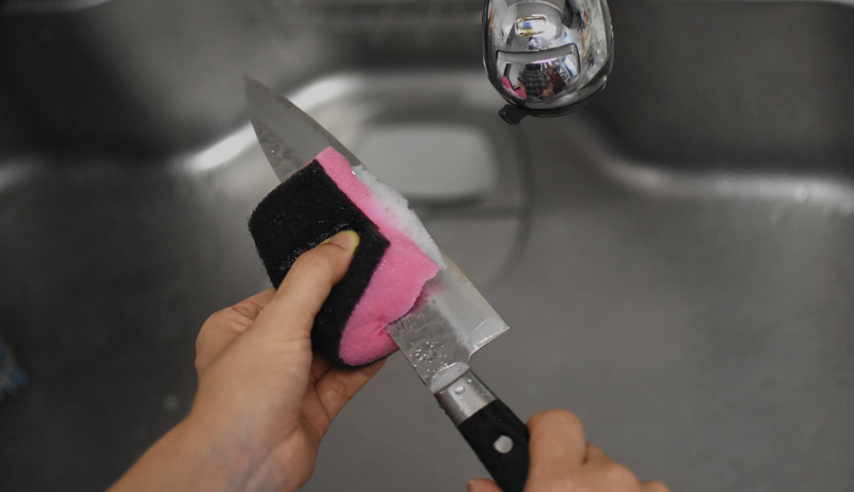
- 3. Dishwashers are a No-Go:
- **Never put a Wabocho knife in a dishwasher.** The high temperature, high-pressure water flow, and strong detergents in a dishwasher can severely damage the knife for the following reasons:
- Rapid rust formation: The high-temperature, humid environment and detergents can rapidly promote rust, especially on carbon steel knives.
- Blade chipping or deformation: Contact with other dishes or strong water flow may cause the blade to chip or bend.
- Handle deterioration: Wooden handles may crack, deform, or have their adhesive peel off due to the high temperature and moisture of the dishwasher.
- **Never put a Wabocho knife in a dishwasher.** The high temperature, high-pressure water flow, and strong detergents in a dishwasher can severely damage the knife for the following reasons:
Perfect Drying: The Battle Against Rust
Once cleaning is complete, it is most important to wipe off all moisture immediately to prevent rust.
- 1. Wipe Immediately with a Dry, Clean Cloth:
- Choose towels or cloths that are lint-free and highly absorbent.
- Carefully wipe the entire blade and every corner of the handle to ensure no moisture remains. Pay special attention to areas where water droplets are likely to linger, such as the junction between the handle and blade, the spine, and the tip of the blade.
- Even a small amount of water droplets can cause rust to form on carbon steel knives within minutes. It is essential to wipe them thoroughly.
- 2. Air drying is not recommended:
- Thinking that “air drying is sufficient” is a mistake. Moisture in the air or residual moisture left after wiping can cause rust.
- Especially in humid seasons or locations, even after wiping with a dry cloth, we recommend briefly drying in a well-ventilated area as a precaution.
Dealing with Existing Rust
If rust appears on your knife, don’t give up. If the rust is minor, you can remove it using the following methods.
- Eraser: If the rust is minor, you may be able to remove it by rubbing it with a stationery eraser.
- Rust remover eraser/rust remover cleaner: Use a rust remover eraser specifically designed for knives or a rust remover cleaner without abrasives. Follow the instructions and gently polish to remove the rust. After removing the rust, rinse immediately, dry completely, and apply a thin layer of oil if necessary.
- Severe rust: For extensive severe rust, you may need to consult a professional sharpener or carefully remove it with sandpaper (starting with very fine grit), but this carries the risk of damaging the blade, so caution is necessary.
Making daily cleaning and drying a habit is the most basic yet most important “act of care” to prolong the life of your Japanese knife and maintain its beautiful luster and sharpness. By simply adhering to this simple habit, your Japanese knife will remain your best culinary companion for years to come.
4.2 The Art of Sharpening: Maintaining Your Blade’s Razor Edge
The sharpness of a Japanese knife is its soul. The most important process for maintaining and further enhancing this sharpness is **”togi”**. Japanese sharpening techniques are advanced craftsmanship that has been passed down since the days of sword smiths. It is not simply a matter of sharpening the blade, but rather an “art” that extends the life of the knife and maximizes its performance.
Why Sharpen? The True Value of Sharpening
As knives are used over time, the blade tip wears down or chips, causing the sharpness to dull. Sharpening is the process of removing the dulled blade tip and recreating a new, sharp edge.
- Restoring and Enhancing Sharpness: Sharpening restores the knife to its original sharpness, or even sharper than when it was purchased. A sharp knife cuts through food fibers without crushing them, maximizing the natural flavor, aroma, and texture of the ingredients.
- Cooking Safety and Efficiency: Dull knives are prone to slipping on food, increasing the risk of injury. Additionally, they require excessive force, reducing cooking efficiency and placing strain on the arms and shoulders. A sharp knife allows for safe, effortless, and swift cooking.
- Extending the life of your knives: Regular sharpening repairs minor damage to the blade, preventing chipping and breaking of the tip. Proper sharpening allows knives to be used for decades.
- Mental focus and respect for tools: For professional chefs, sharpening knives is a time to confront their own skills and enhance concentration. This reflects a deep respect and gratitude for their tools.
Choosing Whetstones: The Right Partner for Your Wabocho
Three types of whetstones are mainly used for sharpening Japanese knives.
- 1. Coarse Grit Whetstone (#80 – #400):
- Uses: Used when the blade is severely damaged, when the shape of the blade needs to be corrected, or when the angle of the blade tip needs to be significantly changed. It efficiently removes steel.
- Characteristics: The grit is coarse, and sharpening produces a large amount of sharpening slurry (mud). This slurry aids in the sharpening process.
- 2. Medium Grit Whetstone (#800–#2000):
- Purpose: Most frequently used for restoring everyday sharpness. It removes scratches made by the coarse whetstone, further sharpens the blade tip, and establishes the foundation for sharpness. For many Japanese knives, sharpening with this whetstone is the most important step.
- Features: Has finer grit than the coarse whetstone and produces a moderate amount of grinding slurry.
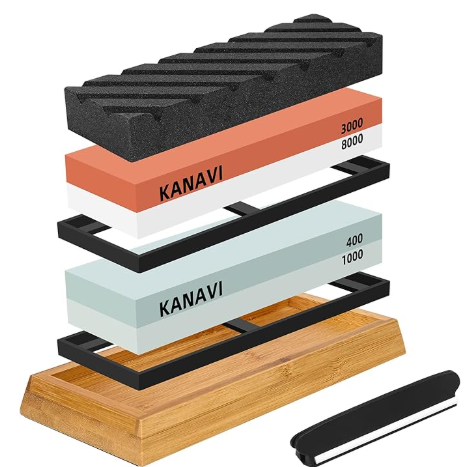
- 3. Finishing Whetstone: #3000 – #8000+):
- Usage: Used in the final stage of sharpening. It removes the fine scratches created by the medium whetstone and sharpens the blade to the utmost smoothness, bringing out the best sharpness and luster. This achieves a sharpness that gives the sensation of “sucking in” the food.
- Features: The grit is extremely fine, producing a smooth sharpening slurry when used. Natural whetstones may also fall into this category.
Sharpening frequency
It depends on the frequency of use, the type of steel used in the knife, and the desired sharpness, but in general,
- Professional chefs: Sharpen with a finishing stone every day or every few days.
- Everyday use at home: Sharpen with a medium stone once every few weeks, and use a finishing stone as needed. If you feel that the knife has become dull, sharpen it without hesitation.
How to Sharpen Wabocho: Fusion of Technique and Feel
Sharpening Japanese knives requires practice and experience, but anyone can learn how to do it once they understand the basic steps and key points. Sharpening single-edged knives in particular requires different techniques than sharpening double-edged knives.
- 1. Whetstone Preparation:
- Soak the whetstone in water until no more bubbles appear (several minutes to several tens of minutes). This prevents the surface of the whetstone from drying out during sharpening.
- Place the whetstone on a damp towel or secure it to a dedicated whetstone stand to keep it stable. Sharpening with an unstable whetstone can cause injury.
- 2. Maintaining the Correct Angle:
- This is the most important point of sharpening. The angle of Japanese knife blades varies depending on the type, but generally, single-edged knives (yanagiba, deba, usuba) are about 15 degrees, and double-edged knives (gyuto, santoku, petty) are about 10 to 15 degrees.
- Place the blade on the surface of the whetstone and gently press the tip of the blade with your fingers. It is important to maintain a consistent angle between the blade and the whetstone.
- With experience, you will be able to judge the optimal angle by the “feel” and “sound” of the blade hitting the whetstone.
- 3. Sharpening Motion:
- How to sharpen a single-edged knife:
- Sharpening the “front side”: The basic method is to sharpen the front side of the blade (the side facing your dominant hand, where the blade is angled). Slide the knife evenly across the whetstone to sharpen the entire blade (from the base to the tip).
- Creating a “burr”: As you sharpen, a small metal protrusion (burr) will form on the opposite side of the blade tip from the side you are sharpening. This indicates that the entire blade has been sharpened.
- Sharpening the “ura (back)”: Once the burr has formed, press the back side of the blade (the flat, unsharpened surface) firmly against the whetstone and lightly sharpen it a few times to remove the burr. This “ura-togi” is the key to enhancing the durability of the blade and maintaining its sharpness.
- How to sharpen a single-edged knife:
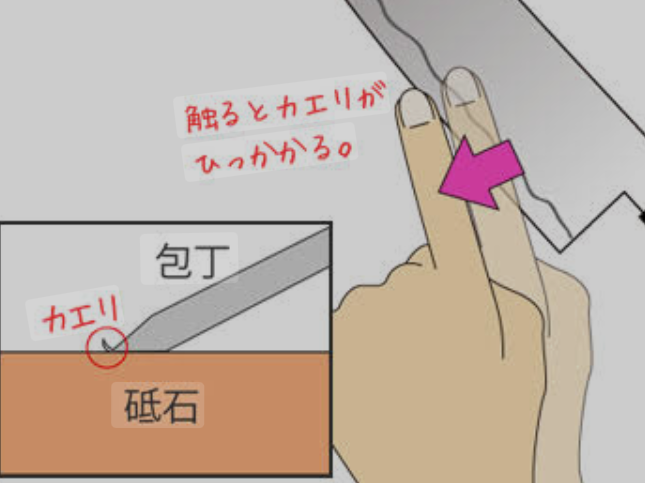
- Sharpening a double-bevel knife:
- Sharpen evenly on both sides. After sharpening one side and creating a burr, sharpen the other side to remove the burr. Repeat this process to sharpen both sides evenly.
- Some knives have asymmetrical sharpening angles, so follow the instructions provided at the time of purchase or consult a specialty store.
- 4. Finishing the Sharpening:
- Progress from the coarse stone to the medium stone, and finally to the finishing stone. Sharpen each stage to completely remove the scratches from the previous stone.
- Once sharpened with the finishing stone, the blade edge becomes as smooth as a mirror, achieving the best cutting performance.
Simple Sharpeners and Professional Sharpeners
- Simple Sharpeners:
- There are also tools such as V-shaped ceramic sharpeners and electric sharpeners that can easily restore sharpness. While convenient for everyday use, these tools tend to over-sharpen the blade or sharpen it at an angle different from the original sharpening angle of the knife, which may shorten the lifespan of Japanese knives or prevent them from achieving their true sharpness. For the delicate blades of Japanese knives, manual sharpening with a whetstone is generally recommended.
- Professional Sharpeners:
- If sharpening on your own is difficult, the blade is severely damaged, or the blade has lost its shape after years of use, we strongly recommend consulting a professional sharpener (Togishi). They use specialized sharpening machines and skilled techniques to restore the knife to its best condition and breathe new life into it. Many knife shops and some Japanese knife specialty stores offer sharpening services.
Sharpening a knife is not just about maintaining its sharpness; it is also a time to connect with the tool and listen to its voice. By mastering this “art of sharpening,” you will deepen your bond with Japanese knives and gain a deeper understanding of Japanese culinary culture.
4.3 Optimal Storage: Protecting Your Wabocho Investment
The Japanese knives you have carefully maintained and sharpened are the embodiment of your passion for cooking and craftsmanship. To protect this valuable “investment” over the long term, proper storage is essential. Improper storage can cause rust, chipped blades, and handle deterioration, significantly shortening the knife’s lifespan.
Moisture is the Enemy: Maintaining a Dry Environment
Moisture is the greatest enemy of Japanese knives, especially those made of carbon steel. To prevent rust, take the following precautions when storing your knives.
- Complete Drying: As mentioned above, be sure to wipe off all moisture after washing. Avoid storing knives in humid places or near sinks where they may come into contact with water.
- Well-Ventilated Area: It is best to store knives in a well-ventilated area where moisture cannot accumulate. Even if you store them in a sealed drawer or cabinet, be sure to ventilate regularly to prevent moisture from accumulating.
Protecting the Blade: Avoiding Physical Damage
The sharp blade of a Japanese knife is extremely delicate. It is important to protect it from contact with other metal objects and impact.
- 1. Magnetic Knife Holder:
- Advantages: This wall-mounted type allows the knife blade to dry easily by exposing it to air and prevents contact with other tools. It also looks beautiful and keeps your kitchen looking neat and tidy. The entire blade is visible, so you can quickly grab the knife you need.
- Precautions: When placing the knife, be careful not to place it roughly, as the blade may hit the holder and become chipped. Place it gently and carefully. Be careful not to pinch your fingers with the strong magnets.
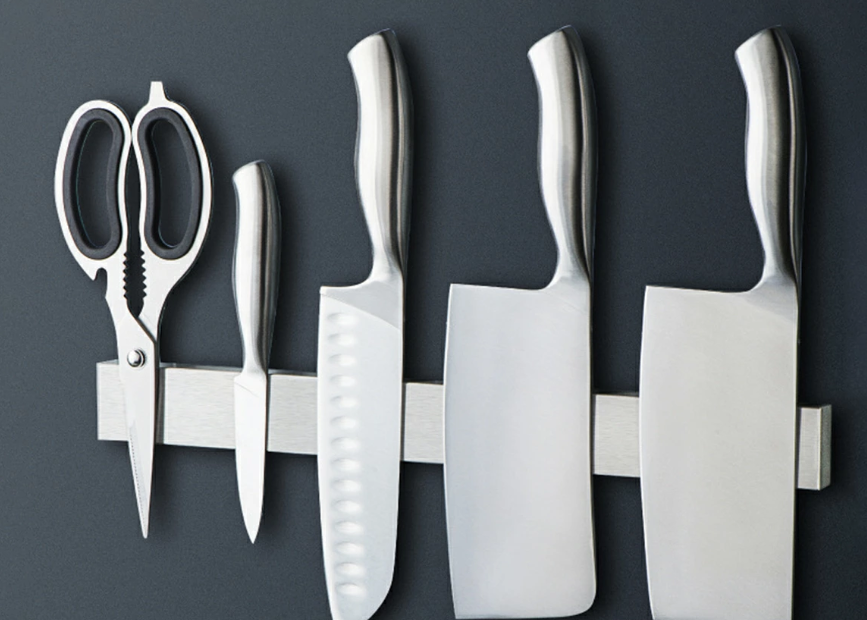
- 2. Wooden Knife Block
- Advantages: The blades are completely covered, making it safe and reducing the risk of injury from accidental contact. It can be placed on the countertop, allowing for easy access to the knives.
- Precautions: Moisture can accumulate in the holes of the block, so it is necessary to regularly remove the knives to ensure proper ventilation and keep the block clean. When inserting or removing knives, be careful not to let the blade tip hit the walls of the block.
- 3. Knife Cases / Saya (Knife Sheaths):
- Advantages: Each knife is protected individually, making it ideal for carrying and long-term storage. In particular, single-edged Japanese knives (such as Yanagiba and Deba) are typically stored in special wooden sheaths (Saya) to protect their delicate blades. The sheaths completely cover the blades, making them highly safe and providing a certain degree of protection from moisture.
- Note: Make sure the knife is completely dry before inserting it into the sheath. Inserting a wet knife into the sheath can cause mold or rust to form inside.
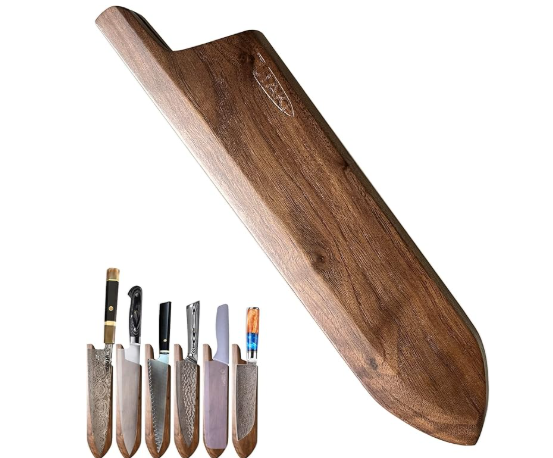
- 4. Drawer Storage:
- Advantages: It keeps the kitchen looking neat and tidy.
- Important Note: To prevent the knife from chipping due to contact with other kitchen tools, store it in a dedicated knife tray or a sheath or blade cover that protects the blade. Avoid storing it haphazardly in a drawer, and it is important to protect the blade so that it is not exposed.
Long-Term Storage Tips: Protecting During Downtime
If you are not going to use your Japanese knife for a while, it requires extra care.
- 1. Ensure Complete Dryness: First, wash and dry the knife thoroughly, just as you would for regular maintenance.
- 2. Apply Oil:
- Carbon steel knives in particular should be coated with a thin layer of edible oil (such as camellia oil or salad oil, preferably odorless) to block contact with moisture and oxygen in the air, effectively preventing rust.
- Take a small amount on a soft cloth and apply it thinly and evenly over the entire blade.
- 3. Wrap in Newspaper:
- After applying oil, wrapping the knife in newspaper or oil paper helps absorb moisture and further prevent rust.
- Then, store it in a dedicated sheath or case in a dry place.
Proper storage is the key to maintaining your Japanese knife’s sharpness and beauty for years to come. It is not merely an act of storing an object, but a testament to the craftsmanship and the gratitude and responsibility for the joy of cooking that the knife brings. Your investment in a Japanese knife will continue to reveal its true value through this careful maintenance and storage.
4.4 Expert Care: When to Seek Professional Sharpening & Repair
If you find yourself in any of the following situations, we recommend that you consult a professional without hesitation.
- 1. Major Chip or Nick in the Blade:
- If the blade has been severely damaged by cutting hard bones or dropping it, it is extremely difficult to repair it at home with a whetstone. Attempting to sharpen it forcefully may cause the blade to become distorted or further damage it.
- Professionals use electric grinders or coarse whetstones to grind down the entire blade and reshape it, forming a new edge depending on the size of the chip.
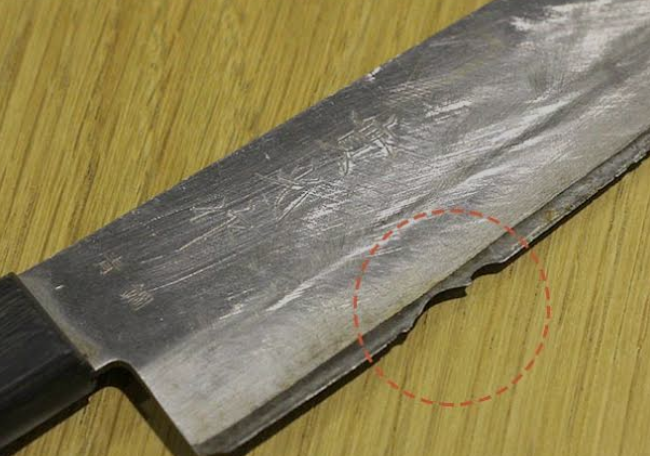
- 2. Severely Wavy or Bent Edge:
- Improper sharpening or strong impact can cause the blade edge to become wavy or visibly bent. This is also a difficult condition to correct at home.
- Professionals can correct the blade distortion and restore the precise blade line.
- 3. Drastic loss of sharpness, unrecoverable by home sharpening:
- If you regularly sharpen your knife yourself but it no longer cuts as well as it used to, the sharpening angle may be off, or the shape of the blade itself may no longer be optimal.
- A professional can accurately diagnose the current state of the blade, resharpen it at the appropriate angle, and restore its original sharpness.
- 4. Restoration of long-unused knives:
- If you want to restore a Japanese knife that has not been used for years or has rusted, a professional sharpener can revive it to a beautiful and sharp condition.
- 5. Sharpening of specialized knives:
- For specialized knives like fugu-cutting knives or extremely expensive knives, attempting to sharpen them on your own carries significant risks. It is wiser to entrust this task to a professional with specialized knowledge and skills.
- 6. First Professional Sharpening:
- New Japanese knives may not be in perfect condition when they leave the factory. Having a professional sharpener sharpen them once can bring out their optimal cutting performance and serve as a benchmark for future self-sharpening.
Points to Note When Requesting Professional Service
- Choose a Reputable Shop:
- Established knife shops: Knife shops with a long history and Japanese knife specialty shops are highly reliable.
- Confirm the presence of craftsmen: If possible, check whether the shop has a resident sharpener or is affiliated with a sharpener.
- Reviews and recommendations: Refer to online reviews and recommendations from acquaintances.
- Visiting areas with many knife specialty stores, such as Kappabashi Tool Street in Tokyo or Sakai City in Osaka, is also a good idea.
- https://www.musashihamono.com/pages/shop-page
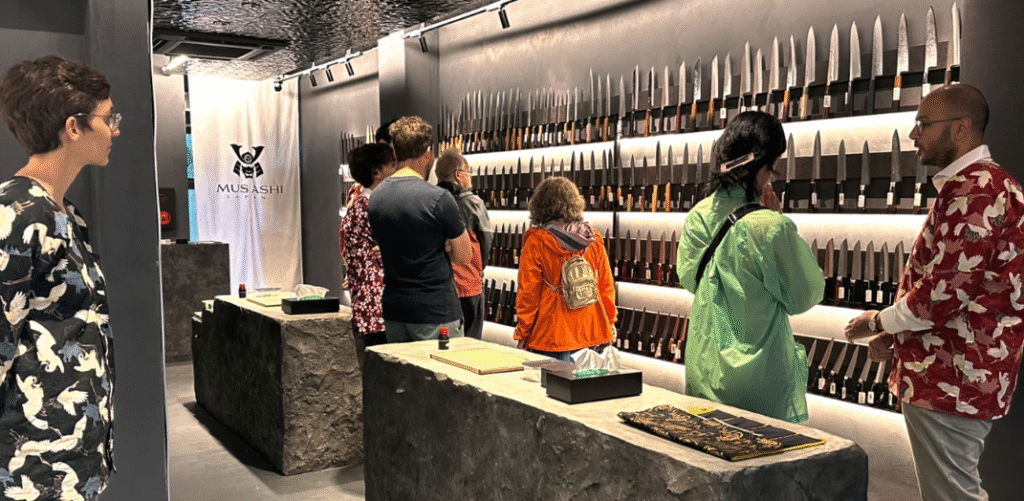
- Confirm Costs and Timeframe:
- Sharpening costs vary depending on the type of knife, the condition of the blade, and the difficulty of sharpening. Be sure to get an estimate in advance.
- The time required for sharpening also varies depending on the workload and the nature of the work. If you are in a hurry, be sure to let them know in advance.
- Clearly Communicate Your Needs:
- “What kind of sharpness do you want? (e.g., sharpness, rust removal, chip repair, etc.)”
- “The knife’s intended use (e.g., for home use, professional use, etc.)”
- “Accommodations for allergies or dietary restrictions (e.g., for cutting specific ingredients)”
- If you have any specific preferences or concerns, be sure to communicate them clearly to the sharpener.
- Check Upon Pickup:
- When picking up the sharpened knife, inspect the blade’s condition, sharpness (if a quick test cut is possible), and ensure there are no abnormalities with the handle. If you have any concerns, ask questions on the spot.
Professional sharpeners do more than just sharpen knives; they perform a “health check” on your knives and provide advice on how to extend their lifespan. Under their skilled hands, even well-used Japanese knives can regain their sharpness and luster, often surpassing that of new knives.
Your Japanese knife is not just a tool; it is a cherished companion that accompanies you on your culinary journey. To ensure it continues to perform at its best, do not hesitate to provide daily maintenance and professional care as needed. By doing so, your Japanese knife will continue to shine with its **”soulful sharpness”** in your kitchen for decades to come.
Conclusion: The Enduring Bond with Your Wabocho
Throughout this chapter, we have embarked on a journey to maintain the perfection of Japanese knives. We have come to understand how simple daily habits such as washing and drying can fundamentally affect the lifespan and sharpness of a knife. In particular, we emphasized the importance of avoiding dishwashers and thoroughly removing moisture.
Next, we focused on the “art of sharpening,” which is the soul of Japanese knives. By learning about the roles of coarse, medium, and finishing stones, as well as the importance of “kaeri” and “ura-to” specific to single-edged knives, you have gained practical knowledge to maintain and enhance the sharpness of your own knives. We hope you have come to realize that sharpening is not merely a technical skill, but a dialogue with the knife and an act of mental focus.
We also explored how proper storage methods are crucial for protecting your investment in Japanese knives. You learned that storage methods such as magnet holders, knife blocks, and dedicated sheaths help protect the blade from physical damage and rust, keeping it in beautiful condition.
Finally, we clarified the appropriate timing for seeking the assistance of a professional sharpener. Recognizing that expert assistance is sometimes necessary for issues such as significant chips, warping, or dullness that cannot be resolved through self-sharpening is a wise decision for maintaining your knife over the long term.
A Japanese knife is not something you acquire and then forget about. It is a living tool that you nurture through daily maintenance, sharpening, and proper storage. This ongoing care is the key to maintaining the **”soulful sharpness”** of Japanese knives and maximizing their true value.
The Japanese knife in your kitchen is not just a tool. It embodies Japan’s rich culinary culture, the skilled craftsmanship of artisans, and a deep respect for tools. By cherishing this wonderful partner, your culinary skills will improve, and your daily cooking will become more enjoyable and fulfilling.


